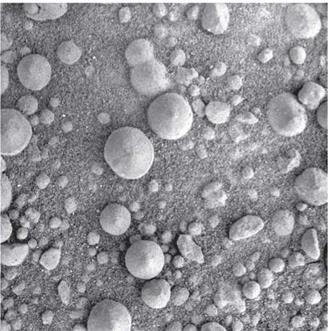What We’ve Learned
Water, water everywhere, but not a drop to drink. The most stunning finding of the Mars rovers, proclaimed the “Breakthrough of the Year” for 2004 by Science magazine,21 was the evidence for the prolonged presence of salty, acidic, and potentially life-supporting water on the surface. This water has long since disappeared, and climate change on Mars is the leitmotif of all the research done by Spirit and Opportunity. The Viking orbiter had provided suggestions of water, but the twin rovers provided indisputable evidence. Below the surface, there are large deposits of ice, with the possibility that some of it might be in aquifers kept liquid by pressure and a modest amount of natural radioactive heating from interior
rocks.22
All life on Earth—from the tiniest bacterium to the mightiest redwood tree—needs water. The jury is still out on whether or not Mars has ever hosted life, but within weeks of arriving on the
|
Figure 3.3. The Mars Exploration Rover Opportunity used its microscopic imager to take this picture of spherules a few millimeters in diameter, just north of Victoria Crater. Nicknamed “blueberries,” the spherules are interpreted as iron-rich concretions formed inside deposits that had long ago been soaked in groundwater (NASA/JPL-Caltech/Cornell/USGS). |
red planet, Opportunity showed that the Meridiani Planum had once been a water-soaked plain.23 Pay dirt was a stone’s throw from the landing site in the form of a rocky outcropping made of layers about as high as a street curb. The outcrop, nicknamed “El Capitan,” contained numerous clues to a watery past. Opportunity found small hard spheres, called “blueberries” by the science team, which were sometimes loosely scattered on the surface and sometimes anchored into rock (figure 3.3). The blueberries were made of hematite, an iron-rich mineral that usually forms on Earth in the presence of water: oxygen atoms from the water bind to iron atoms in the mineral. The team speculated that groundwater carrying dissolved iron had percolated through the sandstone to form the spheres.24 Later on, Opportunity discovered the mineral called jarosite, which only forms on Earth when acidic water is present.25 Water that’s acidic or rich in dissolved iron is quite capable of
hosting microbial life, as we know from the ecosystems found in places like the runoff from the Rio Tinto mine in Spain.
Opportunity also found inch-high rock layers that overlapped and cut into each other. Geologists call such formations cross-beds, and their sizes and shapes indicated that they had been formed by flowing water. Some layers showed weathering by wind so the water must have been present intermittently. The minerals in the cross-beds were rich in sulfur, chlorine, and bromine, which had apparently settled to the bottom of a salty lake or shallow sea. Similar briny deposits are found in desert regions of the Earth. Opportunity also found small vugs, from the Cornish word for cave, and these inch-long or smaller cavities were probably left behind when concentrations of minerals were dispersed by groundwater. Mars minerals tell the tale of a watery past.
Meanwhile, Spirit wasn’t spinning its wheels (yet). It had landed in a volcanic, rock-strewn plain with no obvious signs of sedimentation, but it soon roamed into its own discoveries. A volcanic rock called “Humphrey” had crevices filled with crystallized minerals that had most likely been dissolved in water. On another rocky target called “Clovis,” Spirit found traces of the mineral goethite, which only forms in a terrestrial environment in the presence of water, and telltale enhancements of sulfur, chlorine, and bromine. Spirit also measured a soil sample with a very high concentration of salt, another indirect indication of water.26 Science always deals with finite or incomplete information so it’s important to rule out plausible alternative hypotheses. The alternative explanation for cross-bedding and other sculpting of the surface is wind erosion, but on Earth the signatures of wind and water erosion are quite distinct. Mars was volcanically active in the past, and volcanism can produce spheres from molten drops and cavities, and occasionally minerals like sulphates and jarosite. However, the web of chemical evidence from the rovers, plus the features that can only be explained by the action of water, present a compelling case for an ancient Mars with water on its surface.27
The finding of past water on Mars raises more questions than it answers. Mars has an obliquity—or tilt of its axis as it orbits the Sun—that varies much more than the Earth’s. Orbital tilt causes seasons on any planet. Whereas our tilt is stabilized at close to 23.5 degrees by the Moon, the tilt of Mars is known to have varied from 10 to 60 degrees over the past 100,000 years, and dramatic climate variations were probably occurring in the distant past as well. The idea of a “warmer, wetter” Mars several billion years ago is appealing but is not well supported by climate models and evidence from Martian meteorites.28 The problem is that the planet’s modest gravity is incapable of retaining a thick atmosphere, and the early Sun was fainter than it is today. Some 65-70 degrees of greenhouse warming were needed to bring the surface up to the melting point of water, and while Mars did have early volcanism that generated carbon dioxide, which is a heat-trapping greenhouse gas, the early atmosphere was unlikely to have been thick enough to get the surface temperature above freezing. Mars climate change continues to be enigmatic and difficult to pin down.











